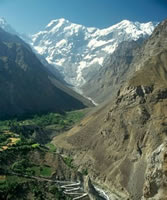RAWALPINDI





 Rawalpindi, Islamabad's Twin City, is located in North East Pakistan and has a population of 1,406,214. It occupies the site of an old village inhabited by the Rawals, a tribe of Yogis. A railroad junction and an important industrial and commercial center, the city has an oil refinery, gasworks, an iron foundry, railroad yards, a brewery, sawmills, and factories making tents, textiles, hosiery, pottery, and leather goods. Sikhs settled the area in 1765 and invited nearby traders to live in Rawalpindi.
Rawalpindi, Islamabad's Twin City, is located in North East Pakistan and has a population of 1,406,214. It occupies the site of an old village inhabited by the Rawals, a tribe of Yogis. A railroad junction and an important industrial and commercial center, the city has an oil refinery, gasworks, an iron foundry, railroad yards, a brewery, sawmills, and factories making tents, textiles, hosiery, pottery, and leather goods. Sikhs settled the area in 1765 and invited nearby traders to live in Rawalpindi.Rawalpindi city, also known as Pindi, has a history spread over several millenniums extending to the ancient times corresponding with the decaying period of Buddhism to the invasions of the Macedonians and then to the dawn of the Muslims era. The long spells of darkness overcast the history of the religion as well as the city before Muslims conquest.
Archaeologists believe that a distinct culture flourished on this plateau as far back as 3000 years. The material remains found on the sight of the city of Rawalpindi prove the existence of Buddhist establishment contemporary to Taxila but less celebrated than its neighbors.
It appears that the ancient city went into oblivion as a result of the Hun devastation. the first Muslim invader, Mahmood of Ghazni (979-1030 AD), gifted the ruined city to a Gakkhar Chief, Kai Gohar. the town, however, being on invaders' route, could not prosper and remained deserted until Jhanda Khan, another Gakkhar Chief, restored it and gave the name of Rawalpindi after the village Rawal in 1493 AD.
Rawalpindi remained under the rule of Gakkhars till Muqarrab Khan, the last Gakkhar ruler, was defeated by Sikhs in 1765 AD. Sikhs invited traders from other places to settle here. This brought the city into prominence. Sikhs lost the city to British in 1849 AD.
Following the British occupation in 1849, the city became permanent cantonment of the British army in 1851. It was around 1881 that the railway line to Rawalpindi was laid. The train service was formally inaugurated on January 1, 1886. The need for having railway link arose after Lord Dollhouse made Rawalpindi the headquarters of the Northern Command. And, Rawalpindi became the largest cantonment in the South Asia.
Rawalpindi, after independence of 1947, has been the home of various political powers and important events that shaped the future of the country. This included the unfortunate murder of First elected prime Minister of Pakistan Liaquat Ali khan, in the Liaquat Garden, in 1951. Rawalpindi has the long time honor of having Army headquarter . Now the Airforce headquarter has also moved here.
The famous Murree road has been the hot spot for the various political and social events. In 2004 Murree road will have its first underpass to decrease the enormous traffic load it faces, every day. The sites proposed for these flyovers and underpasses are Committee chowk, Sixth road and Mareer chowk.
Nala Lai, famous for its floods, runs in the middle of the city, dividing it into city area and Cantt. area. History describes Nala lai water pure enough to do washing clothes but now it has become polluted with the waste water from all sources including factories and houses.
With historical buildings and bazaars, vast parks and high hills and chilling winter and hot summers, Rawalpindi has proven its status as the MUST visit place.
Rawalpindi is known for its colonial-style buildings, rich cultural heritage and colorful bustling bazaars. Though modernity has not made much inroad to this ancient city, there are a number of hotels in Rawalpindi that provide an ideal base to explore the city.
Walking through the bustling bazaars of Rawalpindi is an exciting experience. You may come across a number of items that you would like to shop. Rummaging thorough a maze of shops and wares they sell is an ultimate high for a shopping enthusiast. You can meander through the streets of the Raja Bazaar, which is the old bazaar in Rawalpindi. Sadar Bazzaar, the new market is a different experience altogether. If you have some idea about gold and silver jewellery, Sarafa Bazaar is worth checking out.
The Liaquat Bagh is another interesting tourist destination in Rawalpindi. Quite popular among tourists, the Liaquat Bagh or Liaquat Garden is a fine picnic spot. The Bara Market nearby is the favourite haunt of tourists travelling to Rawalpindi.
If it is scenic views that you are looking forward to on your Rawalpindi tour, head to Shakar Parian Hill. The other tourist places that present scenic views are Murree and Nathiagali. These places are also a serve as the excellent summer-escapes from the heat and dust of Rawalpindi, when the mercury heads northwards during summer.
The other places of tourist attraction in Rawalpindi are Lal Haveli, which is located near the Purana Quilla. A leisurely stroll down the Thandi Sarak or the Mall as it is known is a wonderful experience.
If archaeology is your cup of tea, you can travel to archaeological sites of Gir and Jaulian. Taxila, some 56 kilometres from Islamabad is another historical site associated with the Buddhism.



Comments
Post a Comment